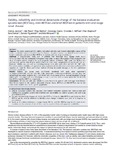Validity, reliability and minimal detectable change of the balance evaluation systems test (BESTest), mini-BESTest and brief-BESTest in patients with end-stage renal disease
| dc.contributor.author | Jácome, C | |
| dc.contributor.author | Flores, I | |
| dc.contributor.author | Martins, F | |
| dc.contributor.author | Castro, C | |
| dc.contributor.author | McPhee, CC | |
| dc.contributor.author | Shepherd, E | |
| dc.contributor.author | Demain, Sara | |
| dc.contributor.author | Figueiredo, D | |
| dc.contributor.author | Marques, A | |
| dc.date.accessioned | 2019-06-06T15:56:24Z | |
| dc.date.available | 2019-06-06T15:56:24Z | |
| dc.date.issued | 2017-09-08 | |
| dc.identifier.issn | 0963-8288 | |
| dc.identifier.issn | 1464-5165 | |
| dc.identifier.uri | http://hdl.handle.net/10026.1/14256 | |
| dc.description | peerreview_statement: The publishing and review policy for this title is described in its Aims & Scope. aims_and_scope_url: http://www.tandfonline.com/action/journalInformation?show=aimsScope&journalCode=idre20 | |
| dc.description.abstract |
PURPOSE: This study determined the validity, test-retest reliability and minimal detectable change of the balance evaluation systems test (BESTest), mini-balance evaluation systems test (Mini-BESTest) and brief-balance evaluation systems test (Brief-BESTest) in patients with end-stage renal disease. METHODS: A cross-sectional study with 74 patients with end-stage renal disease (male 66.2%; 63.9 ± 15.1 years old) was conducted. Participants were asked to report the number of falls during the previous 12 months and to complete the activity-specific balance confidence (ABC) scale. The BESTest was administered, and the Mini-BESTest and Brief-BESTest scores were computed based on the BESTest performance. Validity was assessed by correlating balance tests with each other and with the ABC scale. Test-retest relative reliability and agreement were explored with the intraclass correlation coefficient (ICC) equation (2,1) and the Bland and Altman method. Minimal detectable changes at the 95% confidence level were established. RESULTS: Balance test scores were significantly correlated with each other (spearman's correlation = 0.89-0.92) and with the ABC scale (spearman's correlation = 0.49-0.59). Balance tests presented high test-retest reliability (ICC = 0.84-0.94), with no evidence of bias. Minimal detectable change values were 10.8 (expressed as a percentage 13.5%), 5.3 (23.7%) and 5.6 (34%) points for the BESTest, Mini-BESTest and Brief-BESTest, respectively. CONCLUSIONS: All tests are valid and reliable to assess balance in patients with end-stage renal disease. Nevertheless, based on the minimal detectable changes found, BESTest and Mini-BESTest may be the most recommended tests for this specific population. Implications for Rehabilitation Balance evaluation systems test (BESTest), mini-balance evaluation systems test (Mini-BESTest) and brief-balance evaluation systems test (Brief-BESTest) are reliable and valid in patients with end stage renal disease (ESRD). The minimal detectable changes of 10.8 for the BESTest, 5.3 for the Mini-BESTest and 5.6 for the Brief-BESTest can be used by clinicians to identify a true change in balance over time or in response to interventions. Based on the minimal detectable changes found, BESTest and Mini-BESTest may be the most recommended; and the selection of one of them may be based on time and equipment availability. | |
| dc.format.extent | 1-6 | |
| dc.format.medium | Print-Electronic | |
| dc.language | en | |
| dc.language.iso | en | |
| dc.publisher | Informa UK Limited | |
| dc.subject | Chronic kidney failure | |
| dc.subject | dialysis | |
| dc.subject | postural balance | |
| dc.subject | reproducibility of results | |
| dc.subject | risk assessment | |
| dc.subject | Accidental Falls | |
| dc.subject | Aged | |
| dc.subject | Cross-Sectional Studies | |
| dc.subject | Disability Evaluation | |
| dc.subject | Female | |
| dc.subject | Humans | |
| dc.subject | Kidney Failure, Chronic | |
| dc.subject | Male | |
| dc.subject | Middle Aged | |
| dc.subject | Physical Therapy Modalities | |
| dc.subject | Postural Balance | |
| dc.subject | Psychometrics | |
| dc.subject | Reproducibility of Results | |
| dc.subject | Risk Assessment | |
| dc.title | Validity, reliability and minimal detectable change of the balance evaluation systems test (BESTest), mini-BESTest and brief-BESTest in patients with end-stage renal disease | |
| dc.type | journal-article | |
| dc.type | Journal Article | |
| plymouth.author-url | https://www.ncbi.nlm.nih.gov/pubmed/28886676 | |
| plymouth.issue | 26 | |
| plymouth.volume | 40 | |
| plymouth.publication-status | Published | |
| plymouth.journal | Disability and Rehabilitation | |
| dc.identifier.doi | 10.1080/09638288.2017.1375034 | |
| plymouth.organisational-group | /Plymouth | |
| plymouth.organisational-group | /Plymouth/Faculty of Health | |
| plymouth.organisational-group | /Plymouth/Users by role | |
| dc.publisher.place | England | |
| dcterms.dateAccepted | 2017-08-30 | |
| dc.identifier.eissn | 1464-5165 | |
| dc.rights.embargoperiod | Not known | |
| rioxxterms.versionofrecord | 10.1080/09638288.2017.1375034 | |
| rioxxterms.licenseref.uri | http://www.rioxx.net/licenses/all-rights-reserved | |
| rioxxterms.licenseref.startdate | 2017-09-08 | |
| rioxxterms.type | Journal Article/Review |


